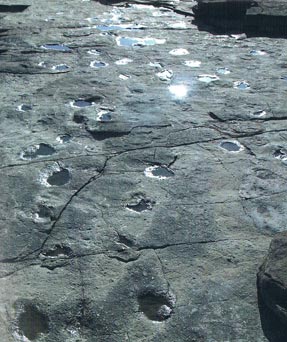Welsh Dinosaur Footprints Vandalised
They might be as much as 200 million years old but the thoughtless actions of fossil hunters have damaged a number of dinosaur footprints preserved at a site of special scientific interest (SSSI) in Wales. A number of prints have been damaged including one that was filled with plaster of paris in a bid to make a cast and then an attempt was made to hammer the cast out of the rock. The fossilised footprints form part of an important palaeontological site in the Vale of Glamorgan. The prints can be found on a stretch of exposed coastline between the towns of Barry and Sully on the northern coast of the Bristol Channel, the trace fossils are the oldest known dinosaur tracks to found anywhere in the British Isles.
Welsh Dinosaur Footprints
The picture above shows one of the three-toed (tridactyl) prints with marks around it where an attempt was made to cut out the fossil from the surrounding rock.
The fossils, which are located in strata that form the Mercia Mudstone Group have been subjected to vandalism before. Sadly, authorities and conservation bodies face a dilemma, do they permit free access to the site so that walkers can view the fossilised footprints and tracks in situ or should the trace fossils be removed and stored in a secure facility to prevent vandalism and fossil thefts?
Back in August 2012, Everything Dinosaur team members reported on the theft of footprint fossils from the same area, fortunately the fossils were recovered a few weeks later.
To read about the earlier fossil theft: Dinosaur Footprints Stolen from the Vale of Glamorgan.
This new damage was discovered by South Wales archaeologist Karl-James Langford whilst he was conducting students around the SSSI.
Mr Langford, the founder of Archaeology Cymru (Archaeology Wales) stated:
“I took a group of ten students to give them the tour of the dinosaur footprints. I could not hide my horror at the damage which had been deliberately caused. We examined one print that had been filled with plaster of paris. On a visit to inspect the damage with another group later that same day, somebody had deliberately tried to smash it out with a breeze block, damaging the 200 million year old print in the process.”
It has also been reported that fires had been lit around the site and rubbish left, calls were made last night to provide this extremely important fossil site with greater protection.
What’s so Special About this Location?
The mudstones exposed on this stretch of the coast running along the northern edge of the Bristol Channel were laid down towards the end of the Triassic Period (Upper Triassic – Norian to Rhaetian faunal stage), dinosaur footprint fossils from this time in Earth’s history are extremely rare and the site is one of the world’s most important in terms of recording the activities of Late Triassic dinosaurs. This was an area of mud flats and silts leading towards the edge of a shallow tropical sea to the south-west. Many different types of ancient reptile crossed these mud flats and their footprints and tracks were preserved.
Hundreds of individual prints have been recorded and something like sixty trackways have been mapped. Most of the dinosaur tracks represent a small, three-toed, theropod which has been given the ichnogenus Grallator. An ichnogenus is a name given to an organism that has left trace fossils, usually tracks, prints or burrows. Other types of dinosaur footprints have been recorded, including tracks representing a large meat-eater (theropod) and a series of trails left by plant-eating prosauropods.
Field Photograph Showing Preserved Trace Fossils at Barry (Vale of Glamorgan)
Picture credit: Tom Sharpe (Dinosaurs of the British Isles)
Dinosaur Tracks
The photograph above shows a number of rounded footprints and tracks. The rounded prints are believed to have been made by a prosauropod dinosaur. Many of the tracks are quite difficult to spot, the best time to see them is in the evening when the low sun casts shadows on those tracks which represent natural casts. In addition, if there has been recent rain, or a high tide many of the trackway depressions will be filled with water and this makes observing the prints much easier.
Team members at Everything Dinosaur would like to echo the comments made by a number of other organisations with regards to this damage. It is essential that sites such as this are protected and safeguarded and we urge all readers to remember that this is a SSSI and as such it is an offence for any person or persons to intentionally or recklessly damage or destroy any of the features of special interest of an SSSI!
If any visitor to this location sees suspicious activity, such as damage to footprints, attempts to make casts or actions that could lead to the theft of a print, please alert the Countryside Council for Wales, the Geology Department of the National Museum of Wales or the Geologists’ Association South Wales Group.
Useful Contacts
For the Geology Department of the National Museum of Wales telephone +44 (0)29 2057 3213
Email: the Geologists’ Association of South Wales Group: [email protected]
For the Countryside Council for Wales, try Natural Resources Wales (Mon-Fri) on 0300 065 3000







Leave A Comment